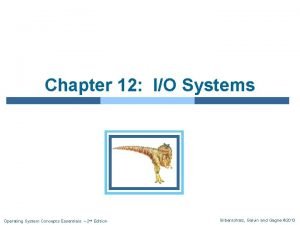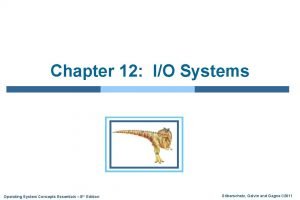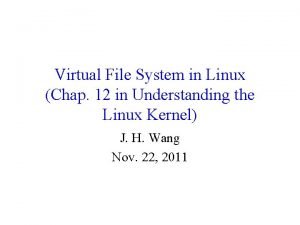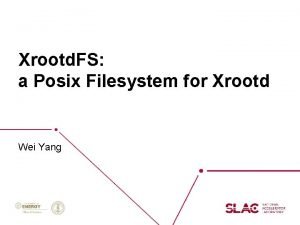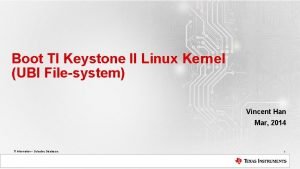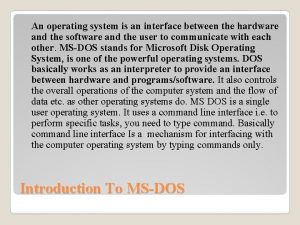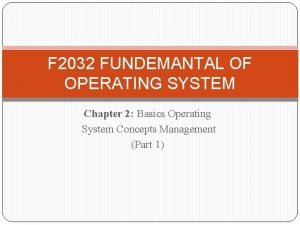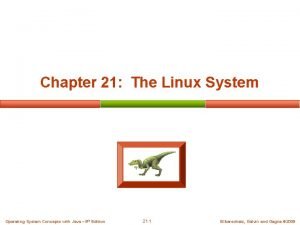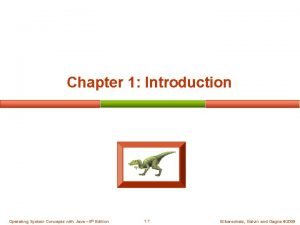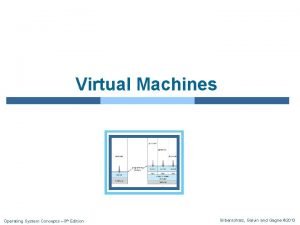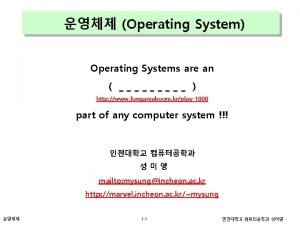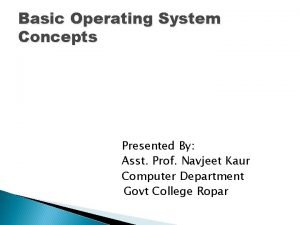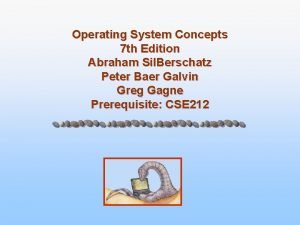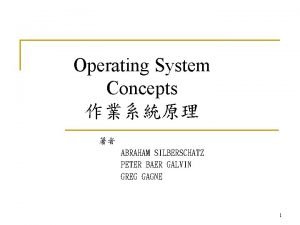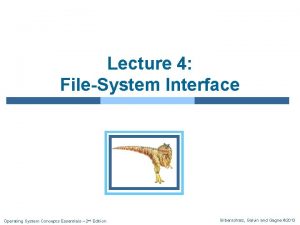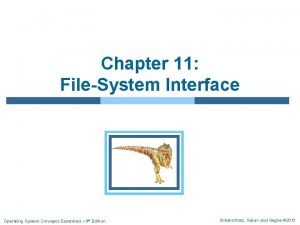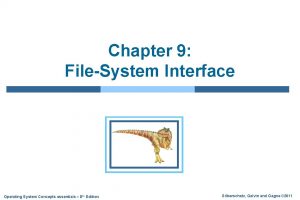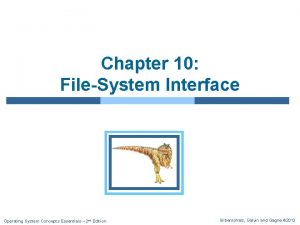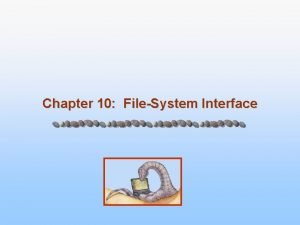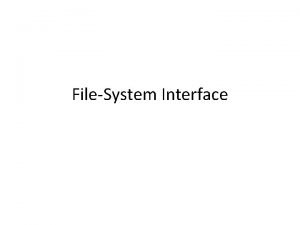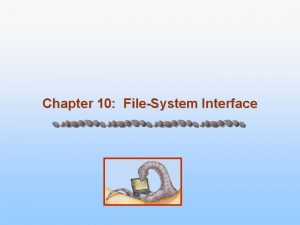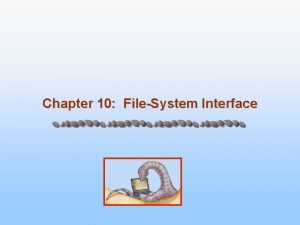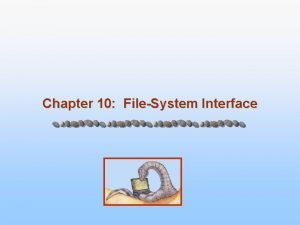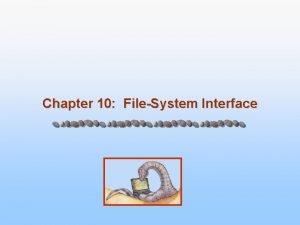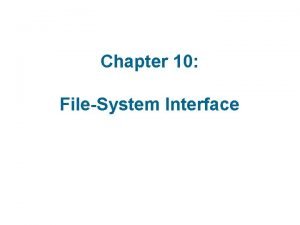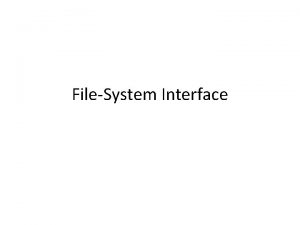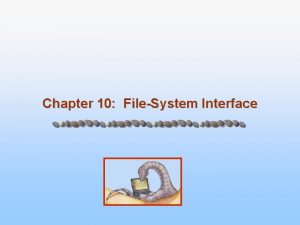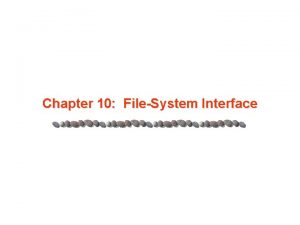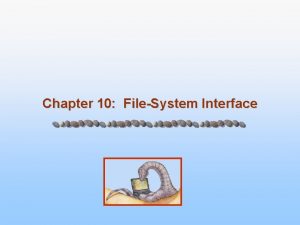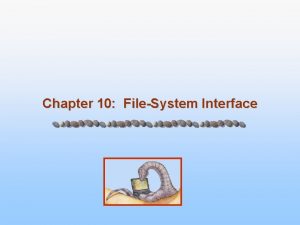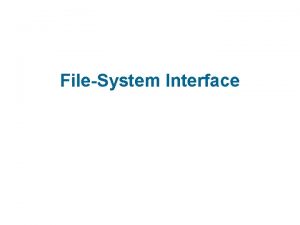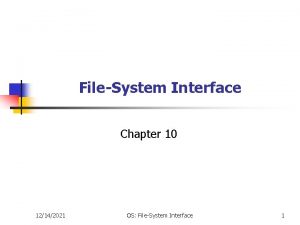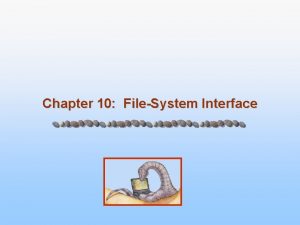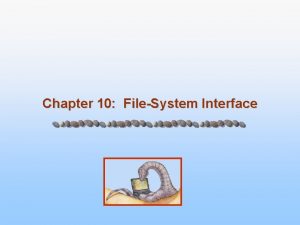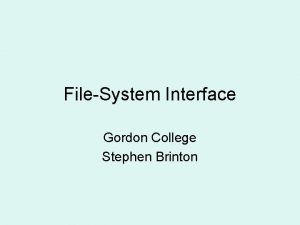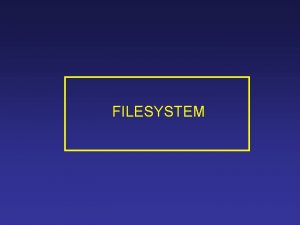Lecture 4 FileSystem Interface Operating System Concepts Essentials




























- Slides: 28

Lecture 4: File-System Interface Operating System Concepts Essentials – 2 nd Edition Silberschatz, Galvin and Gagne © 2013

File-System Interface n File Concept n Access Methods n Disk and Directory Structure n File Sharing n Protection Operating System Concepts Essentials – 2 nd Edition 10. 2 Silberschatz, Galvin and Gagne © 2013

File Concept n Contiguous logical address space n Types: l Data 4 numeric 4 character 4 binary l n Program Contents defined by file’s creator l Many types 4 Consider text file, source file, executable file Operating System Concepts Essentials – 2 nd Edition 10. 3 Silberschatz, Galvin and Gagne © 2013

File Attributes n Name – only information kept in human-readable form n Identifier – unique tag (number) identifies file within file system n Type – needed for systems that support different types n Location – pointer to file location on device n Size – current file size n Protection – controls who can do reading, writing, executing n Time, date, and user identification – data for protection, security, and usage monitoring n Information about files are kept in the directory structure, which is maintained on the disk Operating System Concepts Essentials – 2 nd Edition 10. 4 Silberschatz, Galvin and Gagne © 2013

File info Window on Mac OS X Operating System Concepts Essentials – 2 nd Edition 10. 5 Silberschatz, Galvin and Gagne © 2013

File Operations n File is an abstract data type n Create n Write – at write pointer location n Read – at read pointer location n Reposition within file - seek n Delete n Truncate n Open(Fi) – search the directory structure on disk for entry Fi, and move the content of entry to memory n Close (Fi) – move the content of entry Fi in memory to directory structure on disk Operating System Concepts Essentials – 2 nd Edition 10. 6 Silberschatz, Galvin and Gagne © 2013

Open Files n Several pieces of data are needed to manage open files: l Open-file table: tracks open files l File pointer: pointer to last read/write location, per process that has the file open l File-open count: counter of number of times a file is open – to allow removal of data from open-file table when last processes closes it l Disk location of the file: cache of data access information l Access rights: per-process access mode information Operating System Concepts Essentials – 2 nd Edition 10. 7 Silberschatz, Galvin and Gagne © 2013

Open File Locking n Provided by some operating systems and file systems l Similar to reader-writer locks l Shared lock similar to reader lock – several processes can acquire concurrently l Exclusive lock similar to writer lock Operating System Concepts Essentials – 2 nd Edition 10. 8 Silberschatz, Galvin and Gagne © 2013

File Types – Name, Extension Operating System Concepts Essentials – 2 nd Edition 10. 9 Silberschatz, Galvin and Gagne © 2013

Access Methods n Sequential Access read next write next reset no read after last write (rewrite) n Direct Access – file is fixed length logical records read n write n position to n read next write next rewrite n n = relative block number Operating System Concepts Essentials – 2 nd Edition 10. 10 Silberschatz, Galvin and Gagne © 2013

Sequential-access File Operating System Concepts Essentials – 2 nd Edition 10. 11 Silberschatz, Galvin and Gagne © 2013

Other Access Methods n Can be built on top of base methods General involve creation of an index for the file n Keep index in memory for fast determination of location of data to be operated on n If too large, index (in memory) of the index (on disk) n Operating System Concepts Essentials – 2 nd Edition 10. 12 Silberschatz, Galvin and Gagne © 2013

Directory Structure n A collection of nodes containing information about all files Directory Files F 1 F 2 F 3 F 4 Fn Both the directory structure and the files reside on disk Operating System Concepts Essentials – 2 nd Edition 10. 13 Silberschatz, Galvin and Gagne © 2013

Disk Structure n Disk can be subdivided into partitions n Disks or partitions can be RAID protected against failure n Entity containing file system known as a volume n Each volume containing file system also tracks that file system’s info in device directory or volume table of contents n As well as general-purpose file systems there are many special-purpose file systems, frequently all within the same operating system or computer Operating System Concepts Essentials – 2 nd Edition 10. 14 Silberschatz, Galvin and Gagne © 2013

A Typical File-system Organization Operating System Concepts Essentials – 2 nd Edition 10. 15 Silberschatz, Galvin and Gagne © 2013

Operations Performed on Directory n Search for a file n Create a file n Delete a file n List a directory n Rename a file Operating System Concepts Essentials – 2 nd Edition 10. 16 Silberschatz, Galvin and Gagne © 2013

Directory Organization The directory is organized logically to obtain n Efficiency – locating a file quickly n Naming – convenient to users n l Two users can have same name for different files l The same file can have several different names Grouping – logical grouping of files by properties, (e. g. , all Java programs, all games, …) Operating System Concepts Essentials – 2 nd Edition 10. 17 Silberschatz, Galvin and Gagne © 2013

Single-Level Directory n A single directory for all users n Naming problem n Grouping problem Operating System Concepts Essentials – 2 nd Edition 10. 18 Silberschatz, Galvin and Gagne © 2013

Two-Level Directory n Separate directory for each user n Path name n Can have the same file name for different user n Efficient searching n No grouping capability Operating System Concepts Essentials – 2 nd Edition 10. 19 Silberschatz, Galvin and Gagne © 2013

Tree-Structured Directories Operating System Concepts Essentials – 2 nd Edition 10. 20 Silberschatz, Galvin and Gagne © 2013

Tree-Structured Directories (Cont. ) n Efficient searching n Grouping Capability n Current directory (working directory) l cd /spell/mail/prog l type list Operating System Concepts Essentials – 2 nd Edition 10. 21 Silberschatz, Galvin and Gagne © 2013

File Sharing n Sharing of files on multi-user systems is desirable n Sharing may be done through a protection scheme n On distributed systems, files may be shared across a network n Network File System (NFS) is a common distributed file-sharing method n If multi-user system l User IDs identify users, allowing permissions and protections to be per-user Group IDs allow users to be in groups, permitting group access rights l Owner of a file / directory l Group of a file / directory Operating System Concepts Essentials – 2 nd Edition 10. 22 Silberschatz, Galvin and Gagne © 2013

File Sharing – Remote File Systems n n Uses networking to allow file system access between systems l Manually via programs like FTP l Automatically, seamlessly using distributed file systems l Semi automatically via the world wide web Client-server model allows clients to mount remote file systems from servers l Server can serve multiple clients l Client and user-on-client identification is insecure or complicated l NFS is standard UNIX client-server file sharing protocol l CIFS is standard Windows protocol Operating System Concepts Essentials – 2 nd Edition 10. 23 Silberschatz, Galvin and Gagne © 2013

Protection n n File owner/creator should be able to control: l what can be done l by whom Types of access l Read l Write l Execute l Append l Delete l List Operating System Concepts Essentials – 2 nd Edition 10. 24 Silberschatz, Galvin and Gagne © 2013

Access Lists and Groups n Mode of access: read, write, execute n Three classes of users on Unix / Linux a) owner access 7 b) group access 6 c) public access 1 RWX 110 RWX 001 Ask manager to create a group (unique name), say G, and add some users to the group. n For a particular file (say game) or subdirectory, define an appropriate access. n Attach a group to a file chgrp Operating System Concepts Essentials – 2 nd Edition G 10. 25 game Silberschatz, Galvin and Gagne © 2013

Windows 7 Access-Control List Management Operating System Concepts Essentials – 2 nd Edition 10. 26 Silberschatz, Galvin and Gagne © 2013

A Sample UNIX Directory Listing Operating System Concepts Essentials – 2 nd Edition 10. 27 Silberschatz, Galvin and Gagne © 2013

Operating System Concepts Essentials – 2 nd Edition 10. 28 Silberschatz, Galvin and Gagne © 2013
 Operating system concepts essentials
Operating system concepts essentials Operating system concepts essentials
Operating system concepts essentials Pathname lookup in linux's virtual filesystem
Pathname lookup in linux's virtual filesystem Posix filesystem
Posix filesystem Ubi filesystem
Ubi filesystem Operating systems lecture notes
Operating systems lecture notes Operating system is an interface between the
Operating system is an interface between the User interface in os
User interface in os Operating system concepts, 10th edition
Operating system concepts, 10th edition Linux operating system concepts
Linux operating system concepts Operating system concepts with java
Operating system concepts with java Operating system concepts 6th edition
Operating system concepts 6th edition Operating system concepts 9
Operating system concepts 9 Real time characteristics of embedded operating systems
Real time characteristics of embedded operating systems Ts 파일 일괄 다운로드
Ts 파일 일괄 다운로드 Operating system concepts chapter 8 solutions
Operating system concepts chapter 8 solutions Operating system concepts chapter 5 solutions
Operating system concepts chapter 5 solutions Operating system concepts chapter 5 solutions
Operating system concepts chapter 5 solutions Basic concepts of os
Basic concepts of os Operating system concepts 11th
Operating system concepts 11th Peter baer galvin
Peter baer galvin 01:640:244 lecture notes - lecture 15: plat, idah, farad
01:640:244 lecture notes - lecture 15: plat, idah, farad Interface in interface java
Interface in interface java Office interface vs industrial interface
Office interface vs industrial interface Office interface vs industrial interface
Office interface vs industrial interface An interface
An interface Operating systems
Operating systems Buddy system memory
Buddy system memory File system in operating system
File system in operating system
